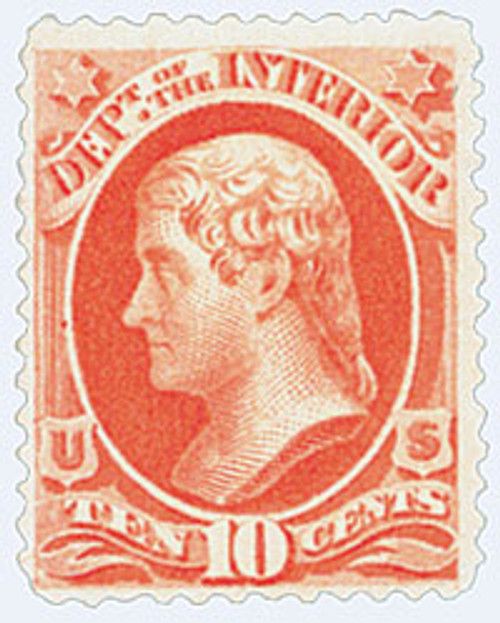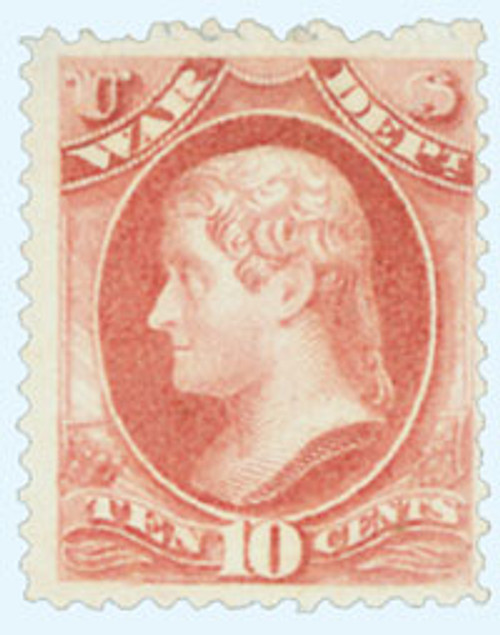
# 188-89 - 1879 10c Jefferson and 15c Webster
Own Classic 1879 Bank Note Stamps
Between 1870 and 1888, America’s stamps were printed by three prominent businesses – the National, Continental, and American Bank Note Companies – in that order. As the stamp-printing contract changed hands, so did the dies and plates used to produce the stamps. To distinguish their stamps from the others, each company printed the stamps with slight variations. That’s one reason many stamp lovers really enjoy studying these classic US stamps.
Identifying the stamps of the Bank Note Era can be quite a challenge. However, information about color variations, paper types and secret marks can make this challenge fun and easy.
Discover Where to Find U.S. #188 & 189’s Secret Marks
US #188 pictures America’s third president, Thomas Jefferson. The American Bank Note Company printed this 10¢ stamp in 1879. The company first used the plates from the Continental Bank Note Company to print the stamps. These plates had a secret mark engraved in them. This mark is located in the scroll at the right end of the “U.S. Postage” ribbon. If you look closely at the scroll, you’ll notice a small semi-circle in its design. That’s the secret mark, ingeniously incorporated into the design. Because it looks so natural, many people might miss such a minor detail.
US #189 features American statesman Daniel Webster. His work helped hold off the Civil War and kept the Union from falling apart. The American Bank Note Company printed this 15¢ stamp in 1879 using former Continental Bank Note plates. These plates left a secret mark in the lower part of the upper left triangle of the stamp. It darkens the V-shaped lines of ink toward the bottom of the triangle. There is some debate among experts whether this is a secret mark or whether wearing down of the plate simply led to more ink being caught in that part of the stamp. This question adds an element of mystery to the 15¢ 1879 Webster.
These tiny differences add to the fun and interest of collecting Bank Note stamps.
What Were These Stamps Used For?
With its 10¢ denomination, #188 was used to pay the registry fee or the double Universal Postal Union rate. So it could have franked a registered letter. Or it could have sent a letter over the standard weight to many nations overseas. There was a great demand for the stamp, and it is much more common in postally used condition.
The 15¢ denomination – #189 – started out paying the 15¢ registration fee until it was reduced to 10¢ in 1875. The stamp also paid for several unusual overseas postage rates. In 1879, American Bank Note began printing the denomination on soft paper, leading to more ink absorption than before. This means US #189 and other American Bank Note stamps have crisper designs than previous printings on hard paper.
Own Classic 1879 Bank Note Stamps
Between 1870 and 1888, America’s stamps were printed by three prominent businesses – the National, Continental, and American Bank Note Companies – in that order. As the stamp-printing contract changed hands, so did the dies and plates used to produce the stamps. To distinguish their stamps from the others, each company printed the stamps with slight variations. That’s one reason many stamp lovers really enjoy studying these classic US stamps.
Identifying the stamps of the Bank Note Era can be quite a challenge. However, information about color variations, paper types and secret marks can make this challenge fun and easy.
Discover Where to Find U.S. #188 & 189’s Secret Marks
US #188 pictures America’s third president, Thomas Jefferson. The American Bank Note Company printed this 10¢ stamp in 1879. The company first used the plates from the Continental Bank Note Company to print the stamps. These plates had a secret mark engraved in them. This mark is located in the scroll at the right end of the “U.S. Postage” ribbon. If you look closely at the scroll, you’ll notice a small semi-circle in its design. That’s the secret mark, ingeniously incorporated into the design. Because it looks so natural, many people might miss such a minor detail.
US #189 features American statesman Daniel Webster. His work helped hold off the Civil War and kept the Union from falling apart. The American Bank Note Company printed this 15¢ stamp in 1879 using former Continental Bank Note plates. These plates left a secret mark in the lower part of the upper left triangle of the stamp. It darkens the V-shaped lines of ink toward the bottom of the triangle. There is some debate among experts whether this is a secret mark or whether wearing down of the plate simply led to more ink being caught in that part of the stamp. This question adds an element of mystery to the 15¢ 1879 Webster.
These tiny differences add to the fun and interest of collecting Bank Note stamps.
What Were These Stamps Used For?
With its 10¢ denomination, #188 was used to pay the registry fee or the double Universal Postal Union rate. So it could have franked a registered letter. Or it could have sent a letter over the standard weight to many nations overseas. There was a great demand for the stamp, and it is much more common in postally used condition.
The 15¢ denomination – #189 – started out paying the 15¢ registration fee until it was reduced to 10¢ in 1875. The stamp also paid for several unusual overseas postage rates. In 1879, American Bank Note began printing the denomination on soft paper, leading to more ink absorption than before. This means US #189 and other American Bank Note stamps have crisper designs than previous printings on hard paper.











